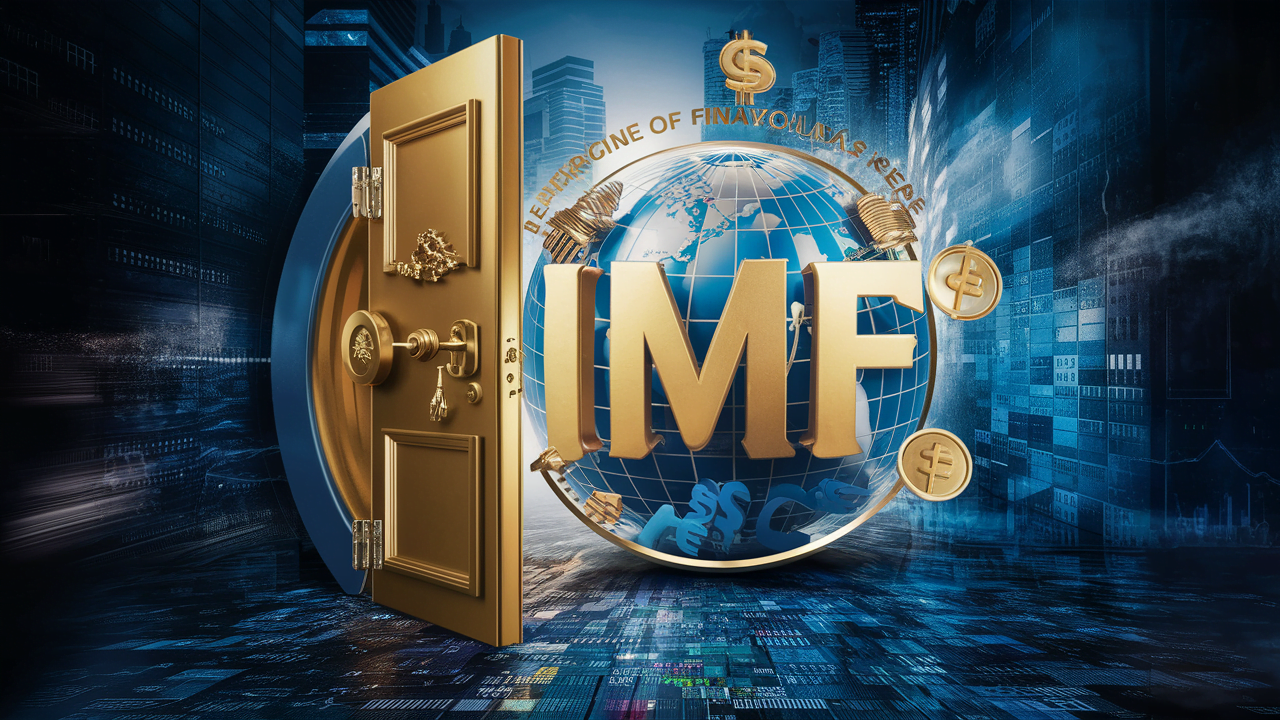In the labyrinthine world of global finance, few acronyms hold as much sway and intrigue as IMF. But what does IMF truly signify in the complex tapestry of economics? Understanding the International Monetary Fund (IMF) is akin to deciphering a pivotal thread woven into the fabric of financial stability worldwide.
As economists pore over policy decisions and nations navigate fiscal challenges, unraveling the mystery of IMF becomes not just a matter of knowledge but a key to unlocking the intricate mechanisms that underpin our interconnected economies.
At its core, the acronym IMF holds the weight of an organization whose implications reverberate across continents and currencies. To delve into what IMF represents is to embark on a journey through both past economic upheavals and future financial landscapes.
For financial professionals navigating fiscal cliffs, economics students dissecting monetary policies, or even curious minds intrigued by the ebb and flow of global markets, comprehending IMF transcends mere academia—it embodies insight into how nations navigate economic turbulences and harmonies alike.
Join us on this expedition into the heart of finance as we embark on unraveling ‘What Does IMF Mean’ – an investigation that promises not just knowledge but a deeper understanding of global economic dynamics.
Exploring the IMF Definition.
The International Monetary Fund (IMF) stands as a pivotal institution in the realm of global finance, aimed at promoting monetary cooperation, ensuring stability in exchange rates, and facilitating international trade. Established in 1944, primarily to oversee the remnants of the Bretton Woods agreement, it has evolved to become a key player in maintaining financial stability worldwide.
The IMF operates as an intergovernmental organization comprising 190 member countries that work collectively towards fostering economic growth and financial orderliness on a global scale.
Primarily tasked with monitoring the international monetary system and providing policy advice or financial aid to member countries experiencing economic difficulties, the IMF functions through a structured system of surveillance and lending programs.
Through its surveillance mechanism, the organization tracks economic developments across different regions, assessing risks to global stability while offering recommendations for policy adjustments to prevent crises.
In cases where countries face financial turmoil that could potentially spread beyond their borders, the IMF steps in by providing loans or technical assistance with conditions attached to ensure economic reform and recovery.
Notably, these conditions often involve implementing structural changes like reducing budget deficits or liberalizing domestic markets to strengthen national economies.
One illustrative example of the IMF’s role can be seen during the Asian Financial Crisis of 1997-1998 when several East Asian economies faced severe currency devaluations and financial instability. The IMF intervened by crafting rescue packages for affected nations like Thailand, South Korea, and Indonesia, prescribing stringent reforms to stabilize their financial systems.
While some critics argue that these measures exacerbated social hardships due to austerity policies, others contend that without such interventions many economies would have plunged into further chaos.
This episode underscores how the IMF’s involvement impacts not only individual countries but also reverberates throughout interconnected markets globally, showcasing its significant role in maintaining economic stability across borders.
Historical Significance of IMF.
The International Monetary Fund (IMF) carries a rich historical legacy that dates back to the end of World War II. Established in 1944 during the Bretton Woods Conference, the IMF came into being with the primary goal of fostering global monetary cooperation and ensuring exchange rate stability.
This period marked a pivotal moment in international relations and economic history as nations sought mechanisms to prevent a financial crisis like the Great Depression from recurring. The IMF’s creation was seen as a way to promote economic stability, facilitate international trade, and provide assistance to countries facing balance-of-payment difficulties.
Over its decades-long existence, the IMF has witnessed numerous milestones and undergone notable transformations. One significant phase in its evolution was the demise of the Bretton Woods system in the early 1970s, leading to shifts in global currency arrangements and prompting the IMF to adapt its policies accordingly.
Throughout its history, the IMF has played a crucial role in assisting member countries facing economic challenges by offering financial support, policy advice, and technical assistance.
Noteworthy events such as debt crises in Latin America during the 1980s and more recent interventions during the Asian Financial Crisis of 1997 have shaped the institution’s approach towards addressing financial instability on a global scale.
Exploring key moments in IMF history unveils not only its adaptive capacity but also sheds light on how geopolitical dynamics have influenced its operations. For instance, tensions between developed economies and emerging markets have at times strained relationships within the organization, reflecting broader power struggles in international finance.
Understanding this historical context is crucial for grasping how the IMF’s role has evolved over time and how it continues to navigate complex economic landscapes amidst shifting global realities.
IMF-Responsibilities.
IMF, as a global financial institution, wields significant influence over economies worldwide through its policy decisions and interventions. The IMF’s impact on the global economy is profound, as its recommendations and conditions attached to financial assistance can shape the economic trajectory of countries seeking help.
For instance, when the IMF requires a country to implement austerity measures as part of a loan program, it can lead to cutbacks in public spending and social services, impacting citizens’ livelihoods.
An example that showcases the direct effect of IMF interventions is Argentina’s economic crisis in 2001. Following the collapse of the Argentine economy, the IMF provided substantial financial assistance but imposed strict conditions focusing on fiscal discipline and structural reforms.
While these measures were intended to stabilize the economy, they also resulted in widespread social unrest and deepening economic hardships for many Argentinians.
Moreover, the outcomes of IMF programs are not always universally positive or well-received by affected nations. In some cases, countries implementing IMF-prescribed policies may experience prolonged recessions or worsened socio-economic conditions.
This highlights the nuanced nature of the IMF’s impact on national economies; while aiming for stability and growth, their policies can sometimes exacerbate existing issues or create new challenges for countries navigating complex economic landscapes.
IMF Criticisms.
Criticisms and controversies have long surrounded the International Monetary Fund (IMF), reflecting the complexity and challenges inherent in its global economic role. One common criticism directed at the IMF concerns the imposition of stringent conditionalities on countries seeking financial assistance.
Critics argue that these conditions, often attached to loans extended by the IMF, can sometimes exacerbate economic hardships for recipient nations rather than facilitating sustainable recovery.
For example, structural adjustment programs enforced by the IMF in past decades required borrowing countries to implement austerity measures, privatization agendas, and market liberalization strategies that drew flak for deepening poverty levels and social disparities in some cases.
Controversial episodes involving the IMF and member countries have further fueled skepticism about the organization’s effectiveness and influence. A notable instance was Argentina’s economic crisis in 2001, where despite multiple rounds of IMF interventions, the country faced severe economic turmoil leading to a default on its debt.
Critics argued that the IMF prescriptions failed to address underlying structural issues while exacerbating social unrest. Additionally, allegations of favoritism or political undercurrents impacting IMF decisions have surfaced over time, raising concerns about transparency and fairness within the institution’s operations.
The contentious relationship between developed nations advocating strong reforms through the IMF and emerging economies pushing back against perceived inequities underscores ongoing debates within global financial governance systems.
The dynamics between power structures, policy impacts on individual nations, and broader implications on international finance continue to shape public discourse around the IMF.
While acknowledging criticisms is essential for fostering constructive dialogue and improvement opportunities, understanding both sides of such debates enriches our comprehension of how institutions like the IMF navigate complexities in striving for global financial stability amidst diverse socio-economic contexts.
Role of IMF in Financial Crises.
The International Monetary Fund (IMF) has historically played a pivotal role during financial crises worldwide, offering assistance to countries facing economic turmoil.
One notable example of the IMF’s involvement was during the 1997 Asian financial crisis. Countries such as Thailand, South Korea, and Indonesia sought IMF support to stabilize their currencies and restore investor confidence.
The IMF provided financial aid and formulated policy frameworks to address the root causes of the crisis, aiding these nations in navigating through challenging times.
Despite its role in managing financial crises, the IMF faces challenges when countries seek its assistance. One common challenge is the imposition of strict conditions known as “conditionality” in exchange for financial support.
These conditions often require countries to implement austerity measures, structural reforms, and fiscal discipline, which can be politically challenging and lead to social unrest. Balancing the need for economic stability with public discontent poses a significant challenge for both the IMF and the countries receiving assistance.
Moreover, another critical challenge faced by countries seeking support from the IMF is ensuring that policy prescriptions align with their national priorities and societal needs. There is often a delicate balance between implementing necessary reforms recommended by the IMF and safeguarding domestic interests.
Striking a harmonious equilibrium between external intervention and domestic sovereignty remains an ongoing challenge for nations grappling with economic crises and turning to the IMF for guidance.
In conclusion, while the IMF has been instrumental in providing financial assistance and policy advice during global financial crises, it continues to navigate complex challenges related to conditionality requirements and balancing international standards with national interests.
Understanding how the IMF operates during financial crises sheds light on its significance in promoting global economic stability while also highlighting areas where improvement may be needed to better address the diverse needs of countries in distress.
Future Prospects for the IMF.
As the global economic landscape continues to evolve, the role of the International Monetary Fund (IMF) is likely to shift in response to new challenges and opportunities. One prediction is that the IMF may increasingly focus on issues related to sustainable development and climate change.
With environmental concerns taking center stage in policy discussions worldwide, there is a growing recognition of the need for financial institutions like the IMF to address these pressing issues.
As a result, we might see the IMF integrating sustainability considerations into its programs and lending practices to support member countries in transitioning towards more environmentally friendly and resilient economies.
Moreover, as digitalization transforms financial systems and cross-border transactions, the IMF may need to adapt its operations accordingly. The rise of cryptocurrencies, fintech innovations, and digital payment systems demands a closer look at how these advancements impact global financial stability.
The IMF could potentially explore new ways of leveraging technology to enhance financial inclusion, streamline processes, and strengthen cybersecurity measures within its member countries.
In terms of structural reforms, it is essential for the IMF to remain agile and responsive to emerging economic challenges. Reforms aimed at improving governance structures, enhancing transparency, and strengthening accountability mechanisms will be crucial for ensuring the continued relevance of the institution.
By staying attuned to changing dynamics in international finance and adopting a forward-looking approach, the IMF can position itself as a proactive player in shaping global economic policies and fostering sustainable development across diverse regions.
In conclusion, while uncertainties persist in the ever-evolving world of finance, one thing remains clear: the IMF’s ability to adapt proactively will be key to its enduring success.
By embracing changes brought about by digitalization, prioritizing sustainability goals, and implementing necessary reforms with foresight, the IMF can navigate future challenges effectively and continue playing a pivotal role in promoting economic stability on a global scale.
Emerging Trends Impacting IMF Policies.
The International Monetary Fund (IMF) operates within a constantly evolving global landscape, influenced by a myriad of emerging trends that shape its policies and decision-making processes. One significant trend affecting the IMF is globalization.
As economies become more interconnected, the IMF must adapt to address cross-border financial issues effectively. Globalization not only complicates economic interdependencies but also necessitates a more coordinated approach to ensure stable financial systems worldwide.
In response, the IMF has increasingly focused on providing policy advice and technical assistance to assist member countries in adapting to globalization’s challenges.
Another pivotal trend impacting the IMF is digitalization. The rapid advancement of technology has transformed financial services and raised new challenges related to cybersecurity, data privacy, and financial inclusion.
To tackle these issues, the IMF has been working on integrating digital finance into its operations and policies. Embracing digital currencies and innovative technologies has become imperative for the IMF to enhance international monetary cooperation, promote financial stability, and support inclusive growth in member countries.
Environmental concerns represent yet another crucial trend influencing the IMF’s policies. Recognizing the urgent need to address climate change and promote sustainable development, the IMF has incorporated environmental considerations into its policy advice and lending programs.
By advocating for green investments, carbon pricing mechanisms, and climate risk assessments in economic strategies, the IMF aims to guide countries toward environmentally sustainable practices while ensuring robust economic performance.
These efforts underscore the IMF’s commitment to addressing pressing global challenges through proactive policy responses aligned with environmental sustainability goals.
In navigating these emerging trends – globalization, digitalization, and environmental concerns – the IMF faces complex decision-making scenarios that require innovative solutions tailored to meet the evolving needs of member nations in an interconnected world.
By staying attuned to these transformative forces shaping the global economy, the IMF can proactively contribute to fostering economic stability, resilience, and sustainable development on a global scale.
Understanding Key Terms Associated with The International Monetary Fund (IMF).
As part of grasping the nuances of the International Monetary Fund (IMF) and its functions, it is essential to familiarize yourself with key terms integral to understanding the IMF’s operations. One such term is the Structural Adjustment Program (SAP), a set of economic policies aimed at assisting countries in resolving balance of payment problems.
SAPs typically involve measures like austerity, liberalization, and privatization that countries need to implement to secure IMF financial assistance. These programs have been both praised for stabilizing economies and criticized for their potential negative social impacts, making them a crucial aspect of discussions surrounding IMF interventions.
Another significant term associated with the IMF is Special Drawing Rights (SDRs). SDRs are international reserve assets created by the IMF to supplement the reserves of its member countries.
They serve as a unit of account rather than a currency, with their value based on a basket of major international currencies. Understanding how SDRs operate is vital for comprehending how the IMF manages global liquidity and supports member countries’ foreign exchange needs during economic crises.
Conditionality represents an essential concept in IMF lending practices. Conditionality refers to the requirements imposed by the IMF on borrowing countries when providing financial assistance. These conditions often include policy reforms, fiscal austerity measures, and structural adjustments aimed at improving economic stability and growth prospects.
The significance of conditionality lies in its role in shaping domestic policies and governance structures in countries seeking IMF support, illustrating the influence wielded by the IMF in promoting economic stability on a global scale.
In summary, mastering these key terms associated with the International Monetary Fund enhances one’s comprehension of how this influential institution operates within the realm of global finance.
Whether delving into Structural Adjustment Programs, Special Drawing Rights, or conditionality requirements, understanding these terms is paramount for individuals aiming to navigate discussions surrounding international financial cooperation and assistance provided by institutions like the IMF.
Conclusion: The Continued Relevance of Understanding What Does ‘IMF Mean’
In the realm of global finance, understanding the International Monetary Fund (IMF) is crucial for financial professionals, economics students, and individuals intrigued by international economic dynamics.
This article has shed light on the IMF’s role in promoting global financial stability through monetary cooperation and policy advice.
Delving into its historical significance, impact on the global economy, criticisms, and controversies surrounding its operations highlighted the multifaceted nature of this influential organization.
As we conclude our exploration into the mystery behind “What Does IMF Mean,” it becomes evident that staying informed about institutions like the IMF is imperative in navigating today’s interconnected world of finance.
By recapitulating key insights into how the IMF operates, impacts economies worldwide, and responds to financial crises, readers are encouraged to maintain a keen interest in understanding global financial institutions.
Continual learning about the IMF equips individuals with vital knowledge to comprehend economic policies at a macro level and empowers them to engage meaningfully in discussions shaping our global financial landscape.
As trends evolve and challenges arise, a solid grasp of what IMF means will remain relevant in fostering informed decision-making within the intricate web of international finance.



